Topics
Category
Era
City of Waconia
The city of Waconia, in Carver County, Minnesota, has a long and rich history. Located just thirty miles southwest of the Twin Cities on the south shore of Lake Waconia, it has long been a tourist destination.
Dakota bands lived in the area near the lake for a long time. They called the lake Bdé Wakonia. This meant "lake of the fountain" or "lake of the spring." Contemporary Dakota translate it as "out of the water comes life." Early white settler-colonists adopted this name for the lake and the town. Over time, it evolved into "Waconia."
Euro-American settler-colonists moved into the Waconia area starting in the early 1850s, after the Treaty of Mendota forced the Dakota to move westward. A Minneapolis surveyor officially surveyed and platted the town site in March 1857. Ludwig Sudheimer and Michael Scheidnagel were the first to build homes in this new town. Later that year, large groups of German immigrants began settling the area. Later immigrants also included Bohemians, Swedes, and the Swiss. By 1858, most of the land along the lake's edge had residents.
St. Joseph's Roman Catholic Church was the first church built in Waconia. The congregation started in 1857 under Reverend Father Bruno Riss. First meeting in private homes, a frame structure was built for church services for $600.00 in 1858. Another building was building was built for the growing congregation in 1875, and that church was replaced by a Chaska brick structure in 1900.
Early businesses established in the 1860s to the 1940s included the Waconia Sorghum Mill, Waconia Steam Saw and Flouring Mill (one of many saw and gristmills), and the Waconia Brewery. The town also had a busy ice harvesting industry. Ice harvesting lasted until the late 1930s, when refrigeration replaced the need for ice. Ice was harvested by cutting blocks of ice out of the lake when it froze over, and packing them in sawdust to keep them from melting as quickly. It was then stored in local ice-houses or shipped to cities.
Although Waconia's growth was negatively affected by the Grasshopper Plagues of 1873–1877, by 1880, Waconia was large enough to be incorporated as a village. With better railroad access, the town became a popular summer destination in 1884, with the development of the large island in the center of the lake into the Coney Island of the West. Town residents had long used the island, once called Paradise Island, for summer recreation. New owners turned it into a resort. The island housed a hotel and dozens of public or privately owned cabins.
There were many hotels in the town limits as well. Tourists spent days, weeks, or the whole summer in Waconia. The town and island resort became the "Paradise of the Northwest" with visitors from around the country. On December 31, 1886, the new Hutchinson Branch of the Great Northern Railway opened. It ran just north of Lake Waconia. This branch was the longest stretch of completely straight rail track in the world. It brought even more people to the lake.
Waconia continued to grow and expand into the twentieth century. The 1904 Waconia Cyclone damaged the town, but residents rebuilt. By 1921, the town had grown enough to be incorporated as a city. The first sanitary sewer system was installed in 1924.
Minnesota's Attorney General Benson filed one of the first environmental lawsuits in Minnesota and America in 1932. The suit accused Waconia Creamery of polluting the lake. The suit ended with both the creamery and city promising better sewage treatment. A 1986 survey of Lake Waconia showed pollution levels lower than in the early 1900s.
In the early twenty-first century, Waconia has continued to grow. A population boom from 6,814 as measured in the 2000 census to 10,697 in the 2010 census made Waconia one of the three largest cities in Carver County. Waconia maintains many businesses and tourist attractions. Among them are the Carver County Historical Society, Ridgeview Hospital, Independent School District #110, Safari Island Community Center, an industrial park, Island View Golf Club, three wineries, and the Historic Andrew Peterson Farmstead.
Bibliography
City of Waconia. Explore Our City- History of Waconia.
http://www.waconia.org/330/History
Waconia Heritage Association. Waconia, Paradise of the Northwest: The Lake and Its Island. Dallas: Taylor Publishing Company, 1986.
Related Resources
Primary
"An Act to Construct Chanel Connecting Minnetonka & Waconia Lakes." Weekly Valley Herald, April 16, 1874.
"Chanhassen: 4 Swedish Men Arrive to Repair Granary Roof of Historic Farm in Scandia." Carver County News, October 12, 2006.
"Coney Island Nominated for National Registry." Waconia Patriot, January 29, 1976.
"County Project Gets Historical Society Grant." Carver County News, July 27, 1978.
"County Seat Question - About Moving It from Chaska to Waconia." Weekly Valley Herald, March 4, 1880.
"Development Plans: Waconia Must Have Sewer & Water Works." Waconia Patriot, May 4, 1922.
"Development Plans: Work Began Gutting the Old City Hall for the Construction of a 13 Unit, Elderly Housing Project." Waconia Patriot, January 12, 1984.
"Island Sold. Soon to Be 'Coney Island'." Weekly Valley Herald, March 13, 1884.
Miller Dunwiddie Architects, Inc. "Coney Island of the West." Research and planning study of Coney Island of the West, Waconia Lake, Carver County, Minnesota : for the city of Waconia. Minneapolis, MN: Miller Dunwiddie Architects, Inc., 1979.
"New City Hall Now Open for Business." Waconia Patriot, January 8, 2004.
Petersen-Biorn, Wendy. "Yellowstone Trail: Remembering the 'Good Road'." Chaska Herald, September 2, 2012.
Ridge, Alice A. and John William. Introducing the Yellowstone Trail: A Good Road from Plymouth Rock to Puget Sound, 1912–1930. Altoona, WI: Yellowstone Trail Publishers, 2000.
Salden, Jessica. "County Interested in Historic Peterson Farm." Carver County News, October 26, 2006.
"Waconia Bicentennial Display Being Shown in Waconia." Waconia Patriot, April 17, 1975.
"Waconia City Hall Nominated to National Register - Photo." Carver County Herald, March 9, 1983.
"Waconia Designated as Logical Place. . .Historical and Veteran's Building to be Erected." Weekly Valley Herald, May 22, 1947.
"Waconia Is Devastated. City Hall Damaged." Waconia Patriot, August 26, 1904.
Warner, George E. and Charles M. Foote. History of the Minnesota Valley: Carver County. Reprint. Carver County Historical Society, 1986. Originally published in George E. Warner and Charles M. Foote, History of the Minnesota Valley, Minneapolis: North Star Publishing Company, 1882.
Westman, Tama. "Swedish Homesteader a Celebrity in Homeland."Chanhassen Villager, March 17, 2005.
Secondary
Carver County: Today and Yesterday. Compiled by the Carver County Statehood Centennial Committee, 1958.
Holcombe, Maj. R.I., ed. Compendium of History and Biography of Carver and Hennepin Counties, Minnesota. Henry Taylor and Company: Chicago, 1915.
"Life in Carver County." Carver County Citizen. 7 no. 2 (December 2006): 1–4.
Lofstrom, Ted and Lynne VanBrocklin Spaeth. Carver County: A Guide to Its Historic and Prehistoric Places. St. Paul: Minnesota Historical Society Press, 1978.
Mihelich, Josephine. Andrew Peterson and the Scandia Story. Minneapolis, MN: Ford Johnson Graphics, 1984.
Overcott, Nancy. At Home in the Big Woods. Lanesboro, MN: Taxon Media, 2002.
Theen, Olive Ireland. Country School Days: The Vanished One Room School. St. Cloud, MN: self-published through Sentinel Print, Co., 1992.
Tremblay, Ruth and Lois Schulstad. Images of America: Carver County. Arcadia Publishing: Charleston, South Carolina, 2011.
Web
City of Waconia.
http://www.waconia.org/
Carver County Historical Society.
http://www.carvercountyhistoricalsociety.org/index.php
Related Images
Two story building with poeple standing and sitting on second floor porch, c.1880. Man seated on first floor porch. Sign on building "LAKE HOUSE/ A.F. SCHUTZ PROP". Dirt street. Man holding the reins on a horse which has a rider. Wood pile visible on left side of building.
This was one of the hotels contributing to Waconia being a summer tourist destination.
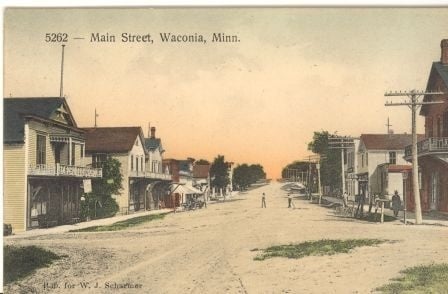
Waconia Street Scene
Holding Location
Articles
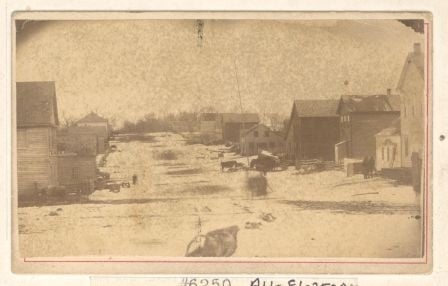
Waconia Street Scene
Holding Location
Articles
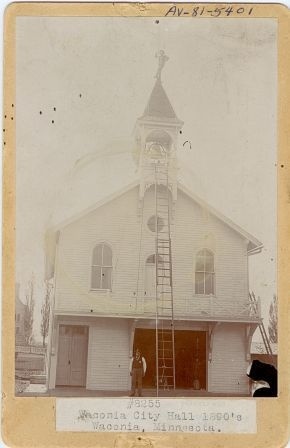
City Hall
Holding Location
Articles
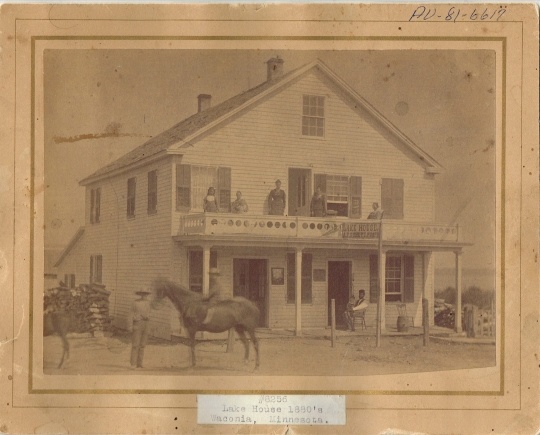
Lake House Hotel
Two story building with poeple standing and sitting on second floor porch, c.1880. Man seated on first floor porch. Sign on building "LAKE HOUSE/ A.F. SCHUTZ PROP". Dirt street. Man holding the reins on a horse which has a rider. Wood pile visible on left side of building.
This was one of the hotels contributing to Waconia being a summer tourist destination.
Holding Location
Articles
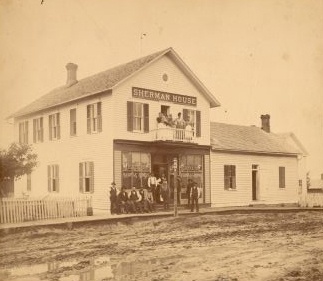
Sherman House Hotel Waconia
Holding Location
Articles
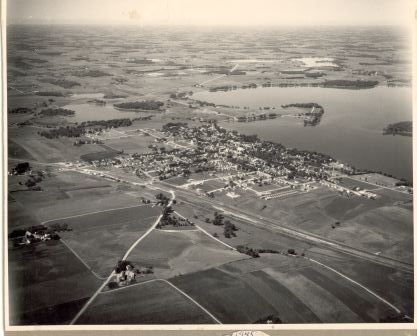
Aerial View of Waconia
Holding Location
Articles

Ice Cutting Crew on East Shore of Lake Waconia
Holding Location
Articles

Waconia City Hall
Holding Location
Articles
Related Articles
Turning Point
Development of Coney Island beginning in 1884 leads to the growth of Waconia as a summer tourist destination, known as the "Paradise of the Northwest".
Bibliography
City of Waconia. Explore Our City- History of Waconia.
http://www.waconia.org/330/History
Waconia Heritage Association. Waconia, Paradise of the Northwest: The Lake and Its Island. Dallas: Taylor Publishing Company, 1986.
Related Resources
Primary
"An Act to Construct Chanel Connecting Minnetonka & Waconia Lakes." Weekly Valley Herald, April 16, 1874.
"Chanhassen: 4 Swedish Men Arrive to Repair Granary Roof of Historic Farm in Scandia." Carver County News, October 12, 2006.
"Coney Island Nominated for National Registry." Waconia Patriot, January 29, 1976.
"County Project Gets Historical Society Grant." Carver County News, July 27, 1978.
"County Seat Question - About Moving It from Chaska to Waconia." Weekly Valley Herald, March 4, 1880.
"Development Plans: Waconia Must Have Sewer & Water Works." Waconia Patriot, May 4, 1922.
"Development Plans: Work Began Gutting the Old City Hall for the Construction of a 13 Unit, Elderly Housing Project." Waconia Patriot, January 12, 1984.
"Island Sold. Soon to Be 'Coney Island'." Weekly Valley Herald, March 13, 1884.
Miller Dunwiddie Architects, Inc. "Coney Island of the West." Research and planning study of Coney Island of the West, Waconia Lake, Carver County, Minnesota : for the city of Waconia. Minneapolis, MN: Miller Dunwiddie Architects, Inc., 1979.
"New City Hall Now Open for Business." Waconia Patriot, January 8, 2004.
Petersen-Biorn, Wendy. "Yellowstone Trail: Remembering the 'Good Road'." Chaska Herald, September 2, 2012.
Ridge, Alice A. and John William. Introducing the Yellowstone Trail: A Good Road from Plymouth Rock to Puget Sound, 1912–1930. Altoona, WI: Yellowstone Trail Publishers, 2000.
Salden, Jessica. "County Interested in Historic Peterson Farm." Carver County News, October 26, 2006.
"Waconia Bicentennial Display Being Shown in Waconia." Waconia Patriot, April 17, 1975.
"Waconia City Hall Nominated to National Register - Photo." Carver County Herald, March 9, 1983.
"Waconia Designated as Logical Place. . .Historical and Veteran's Building to be Erected." Weekly Valley Herald, May 22, 1947.
"Waconia Is Devastated. City Hall Damaged." Waconia Patriot, August 26, 1904.
Warner, George E. and Charles M. Foote. History of the Minnesota Valley: Carver County. Reprint. Carver County Historical Society, 1986. Originally published in George E. Warner and Charles M. Foote, History of the Minnesota Valley, Minneapolis: North Star Publishing Company, 1882.
Westman, Tama. "Swedish Homesteader a Celebrity in Homeland."Chanhassen Villager, March 17, 2005.
Secondary
Carver County: Today and Yesterday. Compiled by the Carver County Statehood Centennial Committee, 1958.
Holcombe, Maj. R.I., ed. Compendium of History and Biography of Carver and Hennepin Counties, Minnesota. Henry Taylor and Company: Chicago, 1915.
"Life in Carver County." Carver County Citizen. 7 no. 2 (December 2006): 1–4.
Lofstrom, Ted and Lynne VanBrocklin Spaeth. Carver County: A Guide to Its Historic and Prehistoric Places. St. Paul: Minnesota Historical Society Press, 1978.
Mihelich, Josephine. Andrew Peterson and the Scandia Story. Minneapolis, MN: Ford Johnson Graphics, 1984.
Overcott, Nancy. At Home in the Big Woods. Lanesboro, MN: Taxon Media, 2002.
Theen, Olive Ireland. Country School Days: The Vanished One Room School. St. Cloud, MN: self-published through Sentinel Print, Co., 1992.
Tremblay, Ruth and Lois Schulstad. Images of America: Carver County. Arcadia Publishing: Charleston, South Carolina, 2011.
Web
City of Waconia.
http://www.waconia.org/
Carver County Historical Society.
http://www.carvercountyhistoricalsociety.org/index.php









